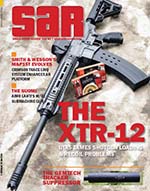Machine Gun Memorabilia: V22N1
By Robert G. Segel
Danish submachine gun qualification breast badges. Left to right: third level (gold) created in 1961, second level (silver) and first level (bronze) both created in 1956. Issued on successful completion of submachine gun training. Central image of the Danish Husqvarna M/44 version of the Finnish Suomi KP-31 submachine gun within a wreath. Sew-on type with three holes in the wreath to sew onto the uniform.
Medallion (challenge coin) for the British Small Arms School Corps Methuen Cup Team. The obverse has the relief image of the Small Arms School Corps insignia of crossed SMLE rifles in front of a Vickers machine gun under the Queen’s crown. The leaves are enameled in green, with red enamel in the crown. The reverse reads, “SASC METHUEN CUP TEAM.” The central image is of crossed L85A2 rifles with SUSAT sights against a green enameled background. Six centimeters in diameter. The Methuen Cup is a British Army inter-corps rifle competition now held in Bisley, UK. The Methuen Cup is the oldest Military Team Shooting Competition in the world. It was first held in 1894 and named after Field Marshal Methuen, who instigated the competition.
British Machine Gun Corps wall banner from the 3rd Royal Tank Regiment. This banner hung in the Sergeants’ Mess at the Regimental Headquarters of the 3rd Royal Tank Regiment. This same banner also hangs at the 1st Royal Tank Regiment Headquarters and the Small Arms School Corps at Warminster. The banner was made in the early 1970s, when the Queen awarded colors to the regiment. The Royal Tank Regiment commissioned it as a remembrance of their roots, which go back to World War I. In 1916, the Machine Gun Corps formed a Heavy Section, later Branch, in order to crew the tanks. The Heavy Branch of the Machine Gun Corps then reformed into a new Tank Corps. The 3rd Royal Tank Regiment (originally C Company) was in existence from 1917 to 1992, when the unit was deactivated and the base closed. The banner was saved by a former 3rd Royal Tank Regiment soldier as everything was being tossed out. Approximately 36 inches square, it has a black background with a heavy gold bullion crown over crossed Vickers machine guns and a “Machine Gun Corps” banner below. With gold bullion fringe, braid and tassel edging.
World War I-era U.S. souvenir pennant. Large felt multi-construction pennant for the 303rd Machine Gun Battalion of the 76th Division. Top part has three blue felt attachment ribbons. Applied and stitched to a blue felt background is “303” over a Colt M1915 Vickers water-cooled machine gun over “BN.” The bottom portion is a red felt background with white stitched “USNA” applied. USNA stands for U.S. National Army. The National Army was the combined conscript and volunteer force formed by the War Department in 1917 to fight in World War I. The National Army was formed from the old core of the regular army augmented by the units of the National Guard and a large draft of able-bodied men. The 76th Division was activated in August 1917 and deployed overseas in August 1918. Upon arrival in France, most of its troops were used as replacements for frontline units.
World War I German reservist commemorative picture. Printed on the matting outside the image is text that reads, “Gren. Bühler Ersatz-Maschinengewehr Compagnie Gren.-Regt. “Königin Olga” (1. Württ.) No. 119” (Grenadier Bühler Reserve Machine Gun Company No. 119, Grenadier Regiment “Queen Olga” 1st Württemberg). The top reads Weltkrieg 1914 / 17 (World War 1914–17). The picture features a photograph of a soldier’s head, which is pasted onto the image of a soldier in feldgrau uniform with the regiment number painted on the helmet. Images include scenes of prone machine gunners with their Maxim guns to the soldier’s left and right. To the rear are horse-drawn machine gun carts. The sky contains early examples of a Taube aircraft and zeppelin.
Australian Veterans Association enameled brass alligator-clip tie clasp for the Australian 2/1 Machine Gun Battalion Association. The name of the maker “Angus & Coote” is marked on the rear. The battalion was raised in 1939 for service during World War II as part of the 6th division as part of the Second Australian Imperial Force (2nd AIF). The 2/1 Machine Gun Battalion saw service in England, Egypt, Greece, Crete, Palestine and Syria. The unit was withdrawn to Australia in 1942 and later fought in the New Guinea campaign (1944) and the Borneo campaign (1945). The unit was disbanded in early 1946.
This article first appeared in Small Arms Review V22N1 (January 2018) |
| SUBSCRIBER COMMENT AREA |
Comments have not been generated for this article.









